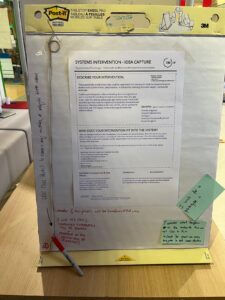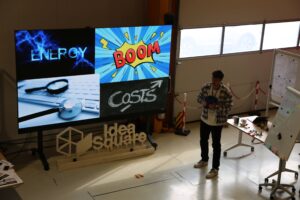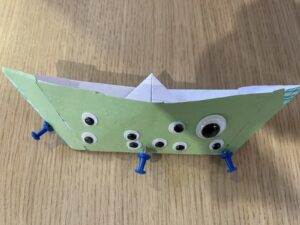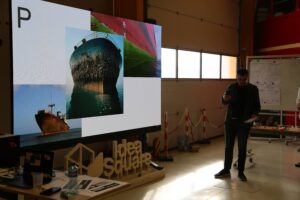Our journey began with the identification of local issues related to water systems prior to our arrival at CERN. To systematically address these challenges, we developed Opportunity Cards that captured key problem areas, including microplastics in water, nitrate contamination, stormwater and flooding, and biofilm formation
During the second week at CERN, we conducted an in-depth analysis of these topics, culminating in the development of targeted solutions for the final presentation. Throughout this process, we honed our ability to rapidly and effectively generate innovative ideas and translate them into tangible prototypes. These prototypes played a pivotal role in demonstrating the feasibility and practical application of our concepts.
The following presents our results:
Genetically modified microbes break down microplastics
Intervention and Functionality:

Genetically modified microbes break down microplastics
Genetically modified microbes are engineered to contain enzymes that break the chemical bonds of plastics, such as polyethylene, polypropylene, or polystyrene. This process reduces plastics into simpler, less harmful molecules.
Application Areas:
- Water treatment and sewage plants
- Microplastic hotspots in nature
- Artificial bioreactors
- Filter and barrier systems in rivers
Integration into the Carbon Cycle:
- The breakdown of microplastics releases CO₂ and water.
- This CO₂ can be utilized by plants and algae during photosynthesis, converting it into biomass and reintegrating the carbon into the natural cycle.
Opportunities and Risks:
- Opportunity: Reducing microplastics and returning carbon to the natural cycle, supporting ecosystems and the food chain.
- Risk: If the microbes are not specific enough to plastics, they might degrade other organic materials, such as natural polymers or cellulose, potentially destabilizing ecosystems.
Potential Users and Supporters:
- Research laboratories
- Biologists and genetic engineers
- Institutions providing financial backing
The proposed solution emphasizes precise development to ensure the microbes specifically target plastics without causing unintended environmental consequences.
Biocorrosion caused by biofouling
The BioBlaster uses accelerated protons to precisely identify and remove biofilms. The energy is directed through pipe walls to eliminate  biofilms effectively without causing unnecessary damage to surrounding materials. It is available in two main configurations:
biofilms effectively without causing unnecessary damage to surrounding materials. It is available in two main configurations:
- A handheld device for manual applications.
- An automated ring that travels along production lines, cleaning pipes autonomously.
Technologies and Features
- Linear Accelerator X: A compact and more powerful upgrade from the previous Linear Accelerator 4.
- CERNbot: Modified into a ring configuration to ensure thorough and efficient pipe cleaning.
- Flexibility: Usable across various levels, from large-scale industrial applications to individual heating systems.
Benefits
- Precision: Minimizes energy waste by targeting biofilms directly.
- Sustainability: Replaces chemical cleaning methods, reducing harmful substances in water and ecosystems, while avoiding environmentally harmful coatings.
- Efficiency: Enables cleaning while the system remains operational, reducing downtime and energy consumption.
- Scalability: Suitable for both large industrial systems and smaller personal systems.
Potential Side Effects and Challenges
- Energy or Particle Emissions: Requires mechanisms to mitigate potential harm.
- Cost: High initial investment and technological development costs.
- Complexity: Requires specialized training for operation and maintenance.
- Limited Scope: Primarily effective for biofilm removal, not other types of contaminants.
Environmental Advantages
The use of protons instead of chemicals eliminates the release of harmful substances into the environment. Additionally, the integrity of the cleaned materials is preserved, as no aggressive substances are applied.
The BioBlaster provides a sustainable and highly precise solution for tackling biofilms, designed to maximize operational efficiency and environmental compatibility.
Biofouling on Ships
Intervention

Biofouling on ships
- Goal: Monitor biofouling on ships with sensors.
- Problem: Biofouling occurs when microorganisms, plants, algae, and small animals settle on submerged surfaces. This leads to:
- Corrosion
- Increased fuel and maintenance costs
- Spread of invasive species
Use of CERN Technology
- Medipix3: For data preprocessing
- CERNbot: For ship cleaning
- C2MON: For large-scale monitoring and control of ship fleets
- ROOT: For big data analysis
Benefits: High impact if implemented on many ships.
System Integration
- Mesosystem (Single Ship)

- Local monitoring of biofouling on individual ships.
- Use of CERNbots to remove biofilms.
- Exosystem (Fleet)
- Monitoring and management of an entire fleet using C2MON.
- Bio-Ecosystem
- Utilizing already collected data to monitor ocean health with ROOT.
Limitations and Assumptions
- Legal regulations for companies are required to ensure effective implementation.
The intervention provides a sustainable solution to reduce biofouling, improve ship efficiency, and support marine health through data-driven approaches.


Recent Comments